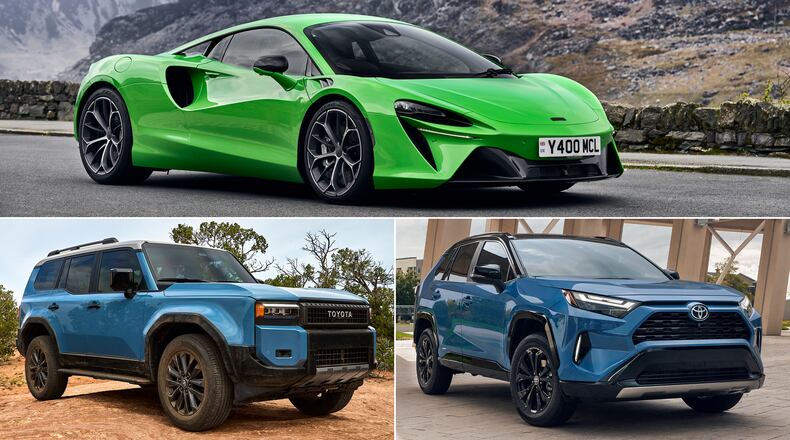Gasoline-electric hybrid vehicles used to be small, dorky hatchbacks and cramped, buzzy sedans. That situation has changed.
Today’s hybrids are diverse, refined and fun.
Almost all Toyota models offer a hybrid
Toyota launched the hybrid ship in the U.S. with the Prius in 2000. The brand has vastly expanded its hybrid lineup since then.
First, there’s the Toyota Camry. Named the “Best New Model” in Kelley Blue Book’s Best Buy Award for 2025, hybrid is now the only way Toyota sells the Camry. Same for the Toyota Sienna minivan — it’s hybrid only. Even the legendary Toyota Land Cruiser uses a hybrid power train. Guess what? Except for the gasoline-only GR86 and Supra sports cars, the all-electric bZ4X and the hydrogen fuel-cell Mirai, every vehicle in Toyota’s 2025 lineup offers a hybrid gasoline-electric power train, either as an option or as standard equipment.
High-performance hybrids
High-performance hybrids make a lot of sense. Automaker McLaren has its roots firmly planted in racing and today’s F1 race cars are hybrid. Racing cars are ultimately about efficiency.
Credit: Special
Credit: Special
Sure, they use that efficiency for rapid acceleration and responsive handling rather than miles per gallon, but today’s hybrid incorporates both. This hybrid technology has trickled down to McLaren’s consumer models, starting with the Artura Coupe and Artura Spider.
Credit: Special
Credit: Special
For many new cars, trucks and SUVs, the hybrid version is the performance or the “top of the line” version since the electric motors work with the gasoline engine, providing instant torque. Torque is a measure of twisting power. That initial feeling of acceleration when leaving a stop light is torque, and hybrids have it in abundance. McLaren is not going to add weight to a car if it doesn’t pay big-time benefits — and it does. The Lincoln Aviator is a good example of a hybrid that combines brisk acceleration and good fuel economy.
The tech has matured
Hybrid technology has matured to the point where it can contribute to a pleasant driving experience. Volvo’s XC90 and XC60 have excellent driving dynamics plus impressive acceleration. The same is true of Volvo’s plug-in hybrids, although plug-in hybrids are considerably more expensive than conventional hybrids.
One challenge for hybrids is the handoff between the gasoline engine and the electric motor or motors. I remember driving a Ford Fusion Energi some years ago and loving the car’s interior and look. However, I found myself trying to keep the car in the electric-only portion of the powerband — the thrust alone is very gratifying. Whenever the gas engine kicked in, there was a noticeable “RRRRrrrrrr” noise, a common audible artifact for hybrid vehicles. Today, engineers have fixed that, and modern hybrids are not that clunky.
Dollars and sense
Hybrids are still less of a value proposition than gasoline-only cars — but that calculation is changing. A nicely equipped gasoline-only powered Toyota Corolla SE starts at $25,900, including the unavoidable shipping cost. A Toyota Corolla SE Hybrid is $27,400 — $1,500 more. If you’re looking for the absolute bottom price, that will be a small gasoline-powered car. Depending on miles and condition, that $1,500 difference will undoubtedly work itself out in the used car market.
Still, $1,500 more for the hybrid version of a popular car isn’t much when you consider the added fuel economy and punchier acceleration.
If you are looking for a fuel-efficient car and have marked hybrids off your list because of experience, try test-driving a newer hybrid. You’ll be surprised.
Brian Moody is a senior editor of Kelley Blue Book and Autotrader and an automotive expert specializing in transportation, car shopping, electric cars, in-car technology and future vehicles.
The Steering Column is a weekly consumer auto column from Cox Automotive. Cox Automotive and The Atlanta Journal-Constitution are owned by parent company, Atlanta-based Cox Enterprises.
About the Author
Keep Reading
The Latest
Featured



